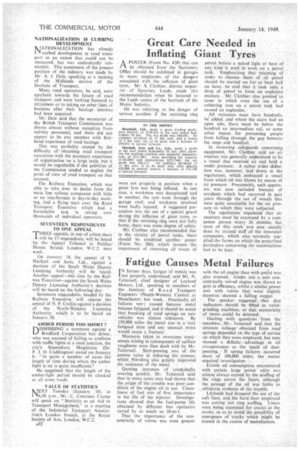Fatigue Causes Metal Failures
Page 34

If you've noticed an error in this article please click here to report it so we can fix it.
I N former days, fatigue of metals was not properly understOod, said Mr. N. Tattersall, chief designer of Leyland Motors, Ltd., speaking to members of
• the Institute of R oa d Transport Engineers' (North-Western Centre) at Manchester,last week. Practically all
• failures were caused because metal
• became fatigued, and it should be noted that breaking of road. sprigs on new vehicles was almost unknown. By 150,000 miles the metal was in a very fatigued state and any unusual stress
would cause a fracture. '
Measures taken to overcome weaknesses arising in consequence of surface roughness were then dealt with by Mr. Tattersall. Shot-peening was of the utmost value in reducing the stresses, whilst, Nitriding also greatly improved the resistance of the metal.
Quoting instances of crankshafts ,wearing quickly. Mr. Tattersall said that in many cases tests had shown that the origin of the trouble was poor condition of the engine oil in use. Cleanliness of fuel was of first importance in the life of the injector. Investigations showed that the fuel-pump life obtained by different bus operators varied by as much as 10-to-I.
—That the importance of the concentricity of valves was even greater
with the oil engine than with petrol was also stressed. Under test a new concentrically valved engine. was shown to gain in efficiency, whilst a similar power unit with valves that were slightly
• eccentric showed ,a falling output. The speaker .suggested that dial indicatorsshould be fitted to valvegrinding machines, so that eccentricity
of stems could be detected. .
• Dealing with .questions from the members. Mr.:. Tattersall said that the ultimate mileage obtained from road Springs depended on the type of service on which they were employed, but tests showed a definite advantage in all circumstances as the result of • shotpeening. If spring failures occurred short of 100,000 miles, the matter required investigation. • • Erratic oil consumption encountered with certain large power units was almost always caused by the scuffing of , the rings across the liners, although the passage of the oil was liable to obliterate evidence of the trouble.
Leylands had dropped the use of the soft liner, and the hard liner employed was cutting out ring scuffing. _Liners were being examined for cracks at the works, so as_to avoid the possibility of emergence of cracks which might be caused in the course of manufacture.




























































































